Caring for new chicks and baby chickens.
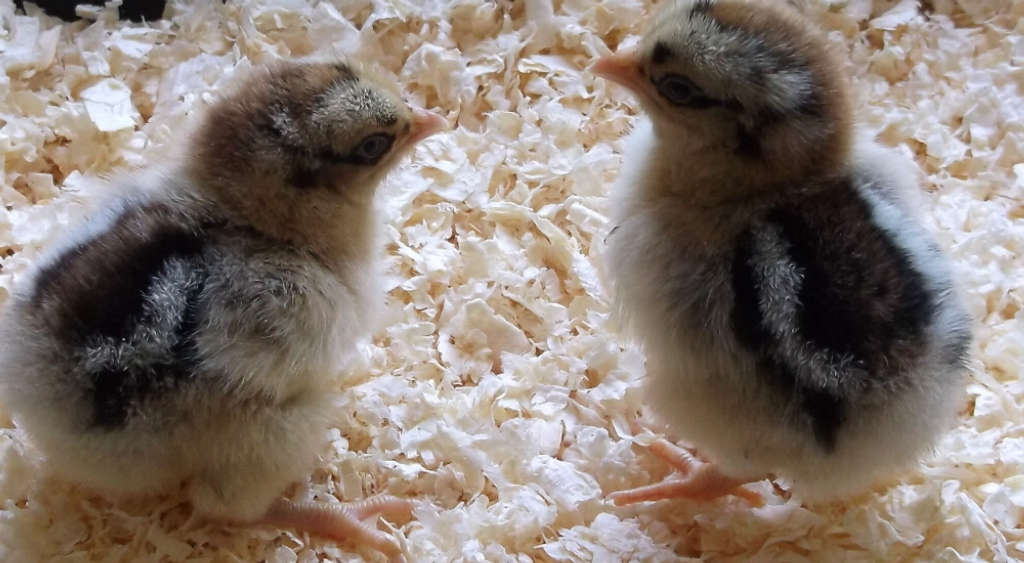
How do you care for newly hatched baby chicks?
Chicks are delightful, fluffy, adorable and hard to resist but baby chickens are very sensitive to their environments and require proper care in order to grow into chickens.
They will need a dry, draught free safe and sturdy brooder and more space as they grow. Quality chick crumb in troughs and fresh water in shallow dishes is needed at all times as well as a few inches of suitable bedding and some amusement to prevent boredom.
Table of Contents
- How do you care for newly hatched baby chicks?
- Caring for baby chicks timeline:
- Baby chicks care:
- Are baby chicks hard to look after?
- What should I use for chick bedding?
- What heat source should I use for baby chicks?
- What wattage of heater do you need for baby chicks?
- What temperature do chicks need to be after they hatch?
- What do you give baby chicks to eat?
- Do baby bantam chicks need special care?
- Can I mix different batches of chicks?
- How long do you keep chicks under a heat lamp?
- Taking care of baby chicks at night:
- Can you put baby chicks outside at all?
- Using heat pads or electric hens:
Chicks will die quickly without food, water, care and a heat source.
Caring for baby chicks timeline:
1. Set up the brooder. It could be a tote, a sturdy card box, a glass aquarium or a shop bought rodent cage. It should be the right size for what you need and strong with a ventilated lid. You can always sub divide one that is too large to begin with and let them have more space as they grow.
2. Site the chick house in a secure and sheltered spot like a spare room, garage or garden shed. Small chicks are vulnerable to predation by just about everything.
3. Fill the habitat with a feeder, water and whatever bedding you choose - see below for ideas.
4. Turn on the heat sources and bring the chick house to the correct temperature. Make sure it is stable and there is no chance of a fire.
5. Allow it to run for at least 8 hours and preferable overnight to settle in.
6. Introduce your new baby chicks all at once, they will be happier than if on their own for any length of time. I like to sit with them for the first hour or so to make sure all is well.
Below: A batch of newly hatched baby chicks.
7. Tend to them often when very young, every few hours at least. Check the water and feed levels and see they are comfortable.
8. Clean as and when but every three days at least and more often as they grow.
9. Provide a dust bath, greens in the form of finely chopped spinach or dandelion leaf, fine grit and a low perch as soon as you think the chicks would benefit from it.
10. Enjoy and play with them.
You can be as creative as you like with a brooder, a friend of mine uses a broken old chest freezer to raise his chicks. It is surprisingly light with all the workings removed, easy to clean and tall sides to prevent escapes. And it can be closed when not in use.
Baby chicks care:
Now that your eggs have just hatched in to new fluffy baby chickens they spend about 24 hours or so still in the incubator or in the hatcher if you are using one, getting their legs and learning how to walk and drying off completely.
One of the big problems with starting with new baby chicks as opposed to point of lay hens is there is more work and time involved. Their are some advantages to starting with baby chickens is you can keep them in a much smaller space for a while and get to know them better. In my experience it makes for tamer birds.
Below: Newly hatched baby chicks still in the incubator.
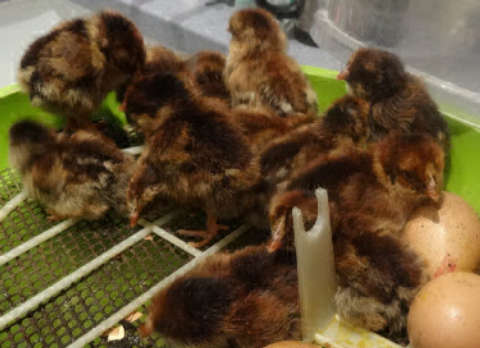
If you have ordered chicks to arrive in the mail from the hatchery you should have a brooder ready and running and warmed up so as not to waste any time. They are likely to be hungry and thirsty after their journey.
Are baby chicks hard to look after?
No, it can be done easily and cheaply with a little thought and planning. My brooders are about as fancy as my candler, but they are functional and safe. I use large totes or plastic boxes (20 to 45 gallon size bought at Walmart ) with a light suspended over them and a layer of sand in the bottom. Sand because it is cheaper, less flammable and doesn't harbour bacteria and spores like damp chick bedding.
There is a whole section on the different floor coverings below.
Below: The red light makes it a little difficult to see but there is a chick asleep on a bed of sand in a large plastic box that holds about 40 gallons.
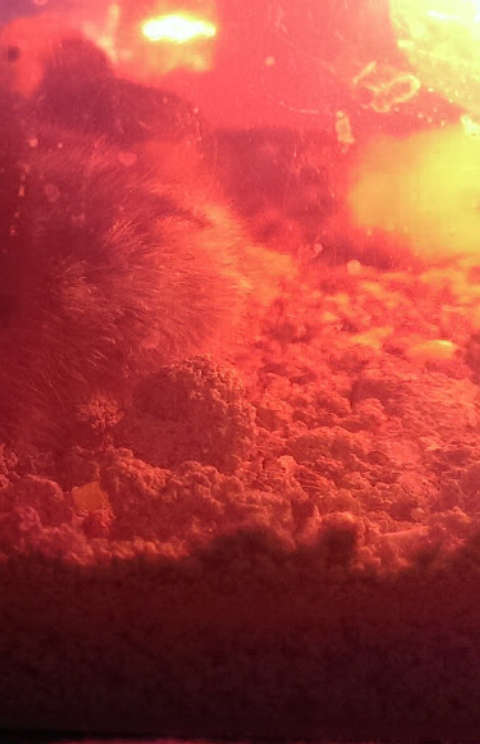
Each chick is taken from the hatcher, banded with a numbered plastic ring, and the number and pedigree info is written down for my records. You can skip this step if you like but it handy to know who is who to start with.
I always keep newly hatched chicks in the house for the first few days. Taking care of baby chicks in the home means I can keep a close eye on them and see how they are getting along.
The first few days, I watch each chick carefully to make sure that they are eating, drinking, that their crop is full, they are pooping normally, and acting normally.
What should I use for chick bedding?
Whichever bedding you choose for your baby chicks it should be changed regularly as in every 3 to 5 days depending on numbers.
- Wood shavings.
- Treated straw.
- Hemp bedding.
- Sand.
- Newspaper or kitchen towel.
- Puppy training pads.
You can use wood shavings or straw bedding, these are normally specially made chick bedding and differ a little from adult chicken bedding. You need to decide based on what you can get hold of easily and within your price range.
Bedding for chicks has usually been dust extracted and steam treated.
Below is a picture from when I still used to use ordinary clear bulbs and wood shavings for brooding chicks.
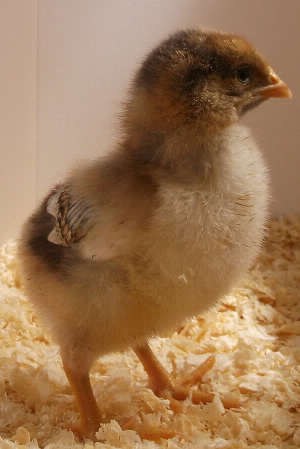
As I mentioned a little earlier, about 6 years ago I made the transition to sand for the bedding in the brooder. It is safer and not the same fire risk as other types. It is easily disposed of into the compost or garden. I also find it holds the heat much better and more importantly does not facilitate the growth of pathogens and moulds with come with damp shavings for example.
They also get to scratching in it just like older birds and it seems better on their feet. Chicks need to scratch just like chickens do to be happy. It is also heavy making the box more stable and it does not contaminate the water or feed like shavings and straw bedding does. The chicks will need to get used to grit in the diet and sand is excellent to get them started.
Newspaper can be slippery and won't help if you have any chicks with weak legs.
Puppy training pads are super absorbent and have no smell. You need to change them every 1 to 3 days depending on how many chicks you have.
I would avoid paper shredding as it is not absorbent at all and quickly form a solid compacted lump.
I have never tried kitty litter or wood pellets so can not comment on those but they seem expensive options.
Do not use heavily scented or oily wood shavings like cedar wood they might smell nice to you but they can be poisonous and don't help the chicks lungs at all.
What heat source should I use for baby chicks?
So do chicks have to have a heat lamp, no not necessarily a lamp, but they will need a source of heat. The option I use most often is the red light bulb. They are cheap, easy to get hold of and easy to use and adjust.
You also need to be careful. Even small bulbs will set fire to a cardboard box and wood shavings.
Below is the options in no special order:
1. A plain light bulb. So this is the ordinary filament incandescent light bulb that gives out both light and heat. It comes in clear and red and these are the 2 types that are interest to keepers.
Red is the best as the light is not so bright and red light seems to have a calming effect on birds. You can get bulbs like this from pet stores or Amazon.
Below: A plain red incandescent light bulb.

2. Gas brooders. This is essentially a gas upside down gas fire that heats the floor space underneath it.
Generally for commercial producers and larger areas and outdoors as the flue gases need to be vented and the fire risk is high. These are mostly for 500 and up chick numbers.
Below: A gas brooder.

3. Ceramic bulbs. This is a like a large flat light bulb and it fits into the socket like one. It is made of porcelain and hangs lower than a bulb. They are much more expensive than ordinary bulbs and are overkill if you are just brooding a few handfuls of chicks at a time.
Below: A ceramic heat bulb.
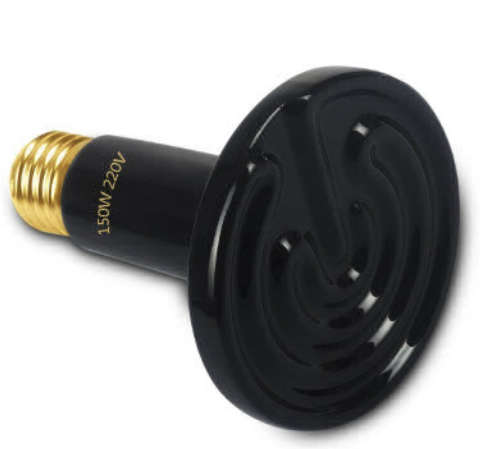
4. Underfloor reptile pads - I have seen this done before but it is expensive and complicated and did not work that well.
5. Electric hens - large square platforms on four legs that can be raised and lowered as needed. I have used several in the past and like every method they have their drawbacks.
Below An electric hen.
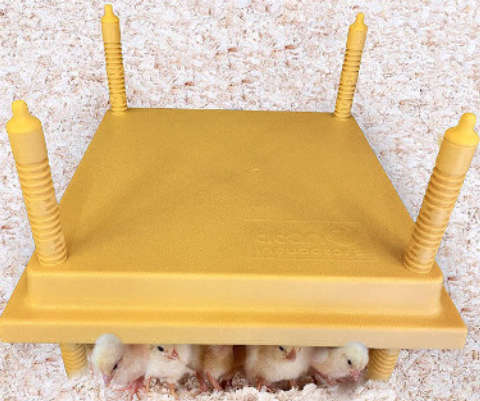
6. Commercially available brooders - These are factory made metal and polycarbonate boxes with integrated heating, feeding and waterers.
What wattage of heater do you need for baby chicks?
I use 2 X 40 Watt red light bulbs. Always at least 2 for reliability. You can use clear but the chicks seem happier under red light. Use more for more chicks rather than higher wattage bulbs. It keeps them spread out rather than crowding around fewer heat sources.
The ceramic heating bulb I have is 150 watts and they are generally much more reliable than the average light bulb. They cover a slightly bigger area.
My Electric hens were 67 Watts for the small and 140 Watts for the large one. They covered about 30 cm square and the large one was 35 X 65 and covered about 60 chicks.
What temperature do chicks need to be after they hatch?
Chicks need to have a temperature gradient in the brooder so they can find their own comfort zone.
The incubator will have been around 99.3 to 100.1 F or 37.6 to 37.8 C and a section of the brooder needs to be at least this temperature and maybe a tiny bit more, even to about 40 / 41 C.
This means the chicks have somewhere to warm themselves quickly if they get cold. A decent thermometer is a necessity I have discovered to achieve balance before the chicks are moved from the incubator.
Below: Chicks in a happy warm circle.
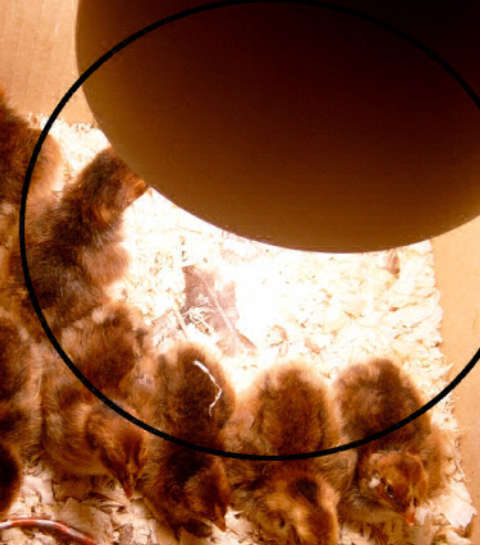
I like to see my chicks in a circle sleeping happily under the lamp, it tells me all I need to know.
You can see in both the above and below images the young birds are sleeping in a circle around the heat source. This means they have found their very own Goldilocks zone of warmth in the brooder.
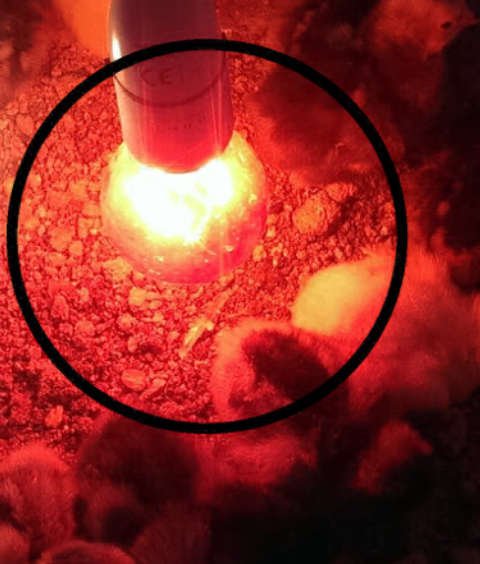
I have found that stability is more important than the actual temperature and best go a little warmer at the beginning. If it's too warm they can move away from it but if it is too cold they will suffer.
Whilst the chicks are indoors I use a 2 X 40 watt red (red is better than clear) regular incandescent suspended over the open top brooder and chick sounds are the best gauge for whether they are comfortable. Happy and comfy chicks make the sweetest little peeping sounds, almost like they are constantly chattering and talking to each other.
I like to use two sources of heat especially when the chicks are so young. I once lost nearly 30 chicks after a single ceramic heat plate malfunctioned whilst I was out at work and by the time I got home they were all dead. It isn't a mistake I will make again.
Below: You should always have 2 heat sources.
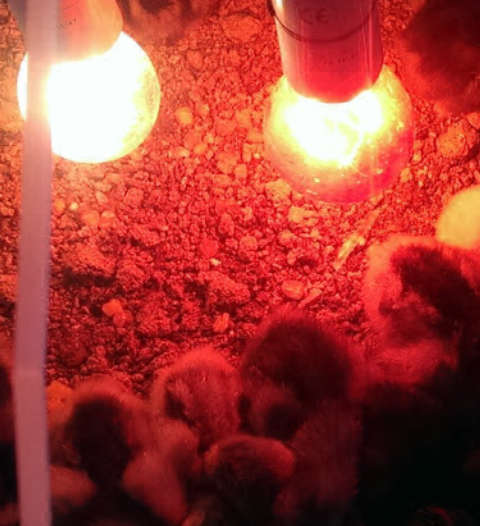
Chicks that are too warm will cram into the corners, pant, sleep more than normal, stand with their wings stretched out and just look miserable.
Too cold chicks will cry plaintively and loudly and huddle directly under the heat source.
I raise the light about 2 to 3 inches after a 3 days and then a little every week as they grow.
What do you give baby chicks to eat?
Chicks require fresh water and chick crumb. Always give small amounts so none is wasted and refill on a regular basis.
I provide a shallow water dish for the first three days, an old plastic tray cut down to hold half an inch of water and some gravel is just fine. Sometimes it helps to pick up the chicks carefully and dip their beaks into the water.
Mine usually take to eating and drinking with a day or so although it may take three. This is chick crumb below, it is medicated for coccidiosis which is a real killer in young chicks.
Below: Chick crumb, It should be the foundation of your new baby birds diet.
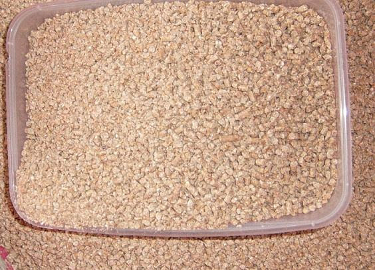
I always cover the floor with newsprint or kitchen towel for the first three days or so. I sprinkle chick starter on the bottom of the brooder to encourage them to eat it doesn't get wasted.
The action of sprinkling the feed-stuff from your fingers will attract their attention as it hits the floor. You are just being mum for a bit till they get used to it. If no one is watching you can make a few bok-bok-bok noises like the mother hen would. I start immediately the chicks have settled into the new space so as they feed as soon as possible.
I find that once accustomed to the food they will find it in the bowl or feeder more or less straight away.
I feed medicated chick starter only for the first six to eight weeks and then begin the transition to growers ration. I supplement the diet with grated hard boiled egg from day one.
Do baby bantam chicks need special care?
Not really, they are just smaller and a little more fragile but should be just fine. I have raised both bantam and large fowl chicks in the same brooder with no issues at all. Because of their small size they get cold quicker than bigger chicks.
Below: Both bantam and full size chicks need the same care and can be reared together.
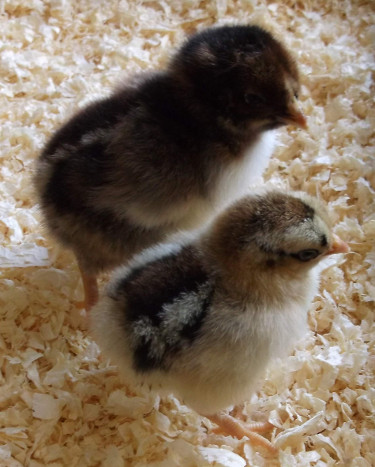
Above is both the Bantam and large fowl chicks of the silver laced Barnevelder. one is nearly twice the size of the other but chicks in the same hatch nearly always seem to get on fine together.
Can I mix different batches of chicks?
I would avoid this if you can, the older chicks will bully the younger ones and they may end up starving. Up to 3 or 4 days apart you may get away with but more than a weeks age difference will cause issues. I have tried this in the past and it always ends in 2 brooders.
I certainly would never plan to mix chicks if you can get away with it. The larger the number of chicks the more likely it is to be a problem, adding a single older to a batch of newer ones may be OK because it solves the loneliness problem.
How long do you keep chicks under a heat lamp?
I like to keep mine under a heat source for at least 6 weeks. Especially if it is cold out or there is wet weather and things are damp. I haven't found that bantams need any longer than their bigger counterparts. I prefer to be safe and give it the extra few days as opposed to being sorry for losing birds.
After a week to 10 days in the house, the new baby chicks are moved to the shed and a larger enclosure made from a ring of cardboard that also has a layer of sand to be cared for in the longer term.
They also graduate to a chick feeder and their waterer is raised on a piece of wood to keep it clean. Their light is provided by a suspended 250 watt heat bulb in a ceramic fixture with a metal surround and a protective shield.
It is suspended over one end of the brooder tub, so that the chicks learn to go to the heat for sleeping, but can move to a cooler spot if they get too warm or as they feather out. I keep them in this brooder for at least 4 weeks, then they graduate to the chick pen depending on the breed and the weather at the time.
The chick pen is a run that measures 8 by 5 feet or thereabouts and should be at least 3 foot high. It has a heat and light source for the younger chicks, and plenty of room for the others.
It has 2 water sources that are raised up on wood or a brick to stop them getting fouled. Feed is now in a hanging feeder. There can be chicks of all ages in this pen, and they stay there until it is warm enough to move them outside. It should be enclosed on three sides to stop draughts and wet.
Your young birds will let you know when they are ready to move on to the next stage by trying to roost on the edges of the brooder and just generally causing mayhem.
This is the method that has worked best for us, but remember that we live in the UK where it rarely gets super cold, and my building is an old store, that is well insulated and doesn't get much below 50 degrees.
Taking care of baby chicks at night:
I was quite surprised how little content there is about looking after young chicks overnight. Overnight requires a bit more care as you will be in bed asleep and not watching over the chicks. Be prepared by taking a few precautions:
- Covering the brooder with non-flammable netting so they can not jump out.
- Making sure you have 2 sources of heat.
- Clean feed and water before you turn in for the night.
- Take care that your brooder is sturdy so as you bulbs don't drop into the brooder etc.
- Use tie wraps to secure loose cords and the like.
- Make sure there is no way they can get tangled in string or cords or drown in the water.
If you are anything like me you will sleep better knowing your newly hatched baby chicks are safe overnight in the brooder.
One other thing you can do is hang a fresh clean mop head in the brooder, the young chicks will snuggle under it like it is a mother hen. It needs to be just an inch of the floor to start with and raise it as they grow just like the light/heat sources.
See also - Do baby chicks need light at night.
Can you put baby chicks outside at all?
If the weather is warm dry and sunny you can put your chicks out in a suitable secured pen from day 2. After all the mother hen takes them wandering as soon as they have dried off underneath her which is normally around day 2.
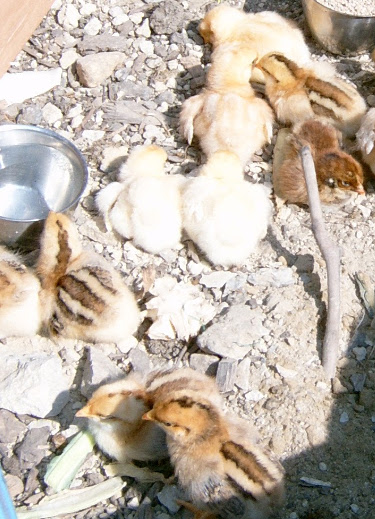
Above: A batch of my newly hatched chicks enjoying the warm June sunshine.
You need to use common sense and limit the time to say 15 to 20 minutes to start with to as much as 30 to 40 as you go into week 2. But only if weather and conditions allow. They still need to be draught free so the enclosure will need solid sides to stop the breeze.
Using heat pads or electric hens:
An electric hen or brooding heat pad is an adjustable warm plate for keeping chicks warm underneath it just as a hen would. I have owned both the ecoGlow by Brinsea and a massive 60cm square monster. Both seemed to make the chicks scared of the outside parts of the brooder and any movement sent them flying underneath it making taming them almost impossible.
Below: This is a batch of light Sussex I raised under an electric hen a few years ago. I used it three times and then sold it. After three to five days the chicks manged to get on top of it, covered it in crap and used it as a springboard to escape.
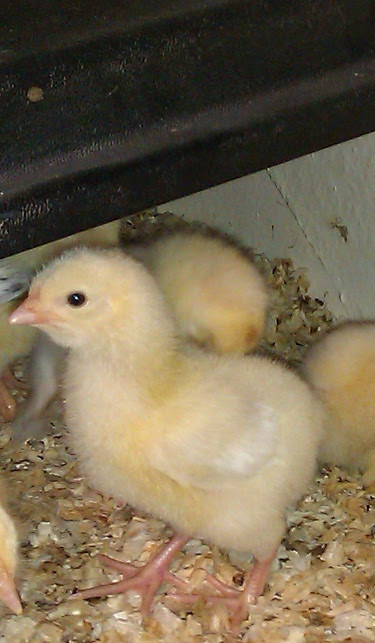
Some people swear by them, I loathe them. If you are unsure then borrow one before you splash out on buying one.
